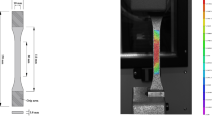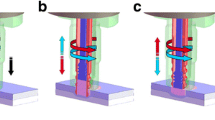Abstract
Currently adhesive metal composite joints based on polymer adhesives play an important role in the production and repair of structures of various applications. However, adhesive bonding during assembly of structural elements from composites and metals results in process-induced (residual) stresses arising in elements of the joint. The nature and level of such stresses depend on physico-mechanical, thermo-elastic and geometric parameters of the bonded materials, adhesive film and kinetics of the adhesive curing process. The purpose of this study is to develop a mathematical model of the adhesive metal composite joint that integrally takes into account the nature of kinetics of the binder curing. The model suggests obtaining of the empirical dependencies, including the minimum number of constants known from the rated values. Based on this model, we obtained the dependences to determine the strains and stresses in the joint during the adhesive assembly process at all stages of the temperature-time diagram. A critical stage of the temperature-time regime has been identified, with the establishing of unfavorable combinations of the values of binder shrinkage and modulus of elasticity of the adhesive, when the joint may fail during the adhesive assembly or its strength may decrease because of high level of residual stresses. Our findings can be effectively used in the future to optimize the technological processes for the production of metal composite structures with due consideration for the properties of specific binders, reinforcing materials, and geometric parameters of constituent elements.
Access this chapter
Tax calculation will be finalised at checkout
Purchases are for personal use only
Similar content being viewed by others
References
Kupski J, de Freitas ST (2021) Design of adhesively bonded lap joints with laminated CFRP adherends: review, challenges and new opportunities for aerospace structures. Comp Struct 268:113923. https://doi.org/10.1016/j.compstruct.2021.113923
Tkachenko D, Tsegelnyk Y, Myntiuk S, Myntiuk V (2022) Spectral methods application in problems of the thin-walled structures deformation. J Appl Comp Mechan 8(2):641–654 (2022). https://doi.org/10.22055/jacm.2021.38346.3207
Vatulia G, Lovska A, Pavliuchenkov M et al (2022) Determining patterns of vertical load on the prototype of a removable module for long-size cargoes. East Eur J Enterp Technol 6(7):21–29. https://doi.org/10.15587/1729-4061.2022.266855
Fomin O, Kulbovskiy I, Sorochinska E et al (2017) Experimental confirmation of the theory of implementation of the coupled design of center girder of the hopper wagons for iron ore pellets. East-Eur J Enterp Technol 5(1):11–18. https://doi.org/10.15587/1729-4061.2017.109588
Orsatelli J-B et al (2023) Bonded flush repairs for aerospace composite structures: A review on modelling strategies and application to repairs optimization, reliability and durability. Compos Struct 304:116338. https://doi.org/10.1016/j.compstruct.2022.116338
Kondratiev A et al (2021) Effects of the temperature-time regime of curing of composite patch on repair process efficiency. Polymers 13(24):4342. https://doi.org/10.3390/polym13244342
Shang X et al (2019) Review on techniques to improve the strength of adhesive joints with composite adherends. Compos B Eng 177:107363. https://doi.org/10.1016/j.compositesb.2019.107363
Kondratiev A, Prontsevych O (2018) Stabilization of physical-mechanical characteristics of honeycomb filler based on the adjustment of technological techniques for its fabrication. East-Eur J Ent Techn 5(1):78–86 (2018). https://doi.org/10.15587/1729-4061.2018.143674
Marques EAS, Carbas RJC, Akhavan-Safar A, da Silva LFM (2022) Adhesively bonded polymer composite joints. In: Hashmi MSJ (eds) Encyclopedia of materials: plastics and polymers. Elsevier, pp 37–57 (2022). https://doi.org/10.1016/B978-0-12-820352-1.00186-3
Kondratiev AV, Kovalenko VO (2019) Optimization of design parameters of the main composite fairing of the launch vehicle under simultaneous force and thermal loading. Space Sci Technol 4:3–21 (2019). https://doi.org/10.15407/knit2019.04.003
Thomas R, Wehler S, Fischer F (2020) Predicting the process-dependent material properties to evaluate the warpage of a co-cured epoxy-based composite on metal structures. Compos A Appl Sci Manuf 133:105857. https://doi.org/10.1016/j.compositesa.2020.105857
Muliana AH (2021) Spatial and temporal changes in physical properties of epoxy during curing and their effects on the residual stresses and properties of cured epoxy and composites. Appl Eng Sci 7:100061. https://doi.org/10.1016/j.apples.2021.100061
Kurennov S, Smetankina N, Pavlikov V et al (2022) Mathematical model of the stress state of the antenna radome joint with the load-bearing edging of the skin cutout. In: Cioboată DD (eds) International conference on reliable systems engineering (ICoRSE)—2021. ICoRSE 2021. LNNS, vol 305. Springer, Cham, pp 287–295. https://doi.org/10.1007/978-3-030-83368-8_28
Barakhov KP, Taranenko IM (2022) Influence of joint edge shape on stress distribution in adhesive film. In: International scientific and technical conference on integrated computer technologies in mechanical engineering, ICTM 2021. Lecture notes in networks and systems, vol 367, pp 123–132. https://doi.org/10.1007/978-3-030-94259-5_12
Gavva LM, Firsanov VV (2020) Mathematical models and methods for calculating the stress-strain state of aircraft panels from composite materials taking into account the production technology. Mechan Solids 55(3):403–412. https://doi.org/10.3103/s002565442003005x
Liu C, Shi YY (2020) A thermo-viscoelastic analytical model for residual stresses and spring-in angles of multilayered thin-walled curved composite parts. Thin-Walled Struct 152:106758. https://doi.org/10.1016/j.tws.2020.106758
Thomas R, Fischer F, Gude M (2021) Adhesives for increasing the bonding strength of in situ manufactured metal-composite joints. Proceed Inst Mech Eng D J Autom Eng 235(13):3256–3269. https://doi.org/10.1177/0954407020965759
Wang WD, De Freitas ST, Poulis JA, Zarouchas D (2021) A review of experimental and theoretical fracture characterization of bi-material bonded joints. Compos B Eng 206:108537. https://doi.org/10.1016/j.compositesb.2020.108537
Vambol O, Kondratiev A, Purhina S, Shevtsova M (2021) Determining the parameters for a 3D-printing process using the fused deposition modeling in order to manufacture an article with the required structural parameters. East Eur J Ent Techn 2(1):70–80. https://doi.org/10.15587/1729-4061.2021.227075
Zhuang W, Shi H, Chen S, Li M (2023) Effect of curing degree on forming of clinch-adhesive joint. J Adhes 1–27 (2023). https://doi.org/10.1080/00218464.2023.2169607
Agha A, Abu-Farha F (2021) Viscoelastic model to capture residual stresses in heat cured dissimilar adhesive bonded joints. Int. J. Adhes. Adhesiv. 107:102844. https://doi.org/10.1016/j.ijadhadh.2021.102844
Boban A, Kurian S, Pooppally TJ et al (2023) Numerical investigation on the strength of different types of adhesively bonded lap joints. Mater. Today: Proceed. 72:2255–2260. https://doi.org/10.1016/j.matpr.2022.09.213
Pavlenko I, Piteľ J, Ivanov V et al (2022) Using regression analysis for automated material selection in smart manufacturing. Math 10(11):1888. https://doi.org/10.3390/math10111888
Schiel M, Dilger K (2014) Kinetic analysis for the determination of cure-dependent mechanical properties of adhesives. Proceed Instit Mech Eng L J Mater Des Appl 228(2):92–99. https://doi.org/10.1177/1464420713520144
Hubert P (2023) Autoclave and out-of-autoclave processing of prepregs. In: Harper L, Clifford M (eds) Design and manufacture of structural composites. Woodhead Publishing, pp 209–236. https://doi.org/10.1016/B978-0-12-819160-6.00020-2
Okolie O, Latto J, Faisal N et al (2023) Manufacturing defects in thermoplastic composite pipes and their effect on the in-situ performance of thermoplastic composite pipes in oil and gas applications. Appl Compos Mater 30(1):231–306. https://doi.org/10.1007/s10443-022-10066-9
Slyvynskyy VI, Verbitskaya NA, Gajdachuk VE et al (2009) Creation of energy-saving technologies of forming articles made of polymeric composite materials. In: 60th international astronautical congress 2009, IAC 2009, vol 7. Daejeon, pp 5601–5607
Baran I, Cinar K, Ersoy N et al (2017) A review on the mechanical modeling of composite manufacturing processes. Archiv Comput Methods Eng 24(2):365–395. https://doi.org/10.1007/s11831-016-9167-2
Author information
Authors and Affiliations
Corresponding author
Editor information
Editors and Affiliations
Rights and permissions
Copyright information
© 2023 The Author(s), under exclusive license to Springer Nature Switzerland AG
About this paper
Cite this paper
Kondratiev, A., Gaidachuk, O., Vambol, O., Nabokina, T., Kryzhyvets, Y. (2023). Effect of Kinetics of Adhesive Curing on Process-Induced Strains and Stresses in the Metal Composite Joint. In: Arsenyeva, O., Romanova, T., Sukhonos, M., Biletskyi, I., Tsegelnyk, Y. (eds) Smart Technologies in Urban Engineering. STUE 2023. Lecture Notes in Networks and Systems, vol 807. Springer, Cham. https://doi.org/10.1007/978-3-031-46874-2_18
Download citation
DOI: https://doi.org/10.1007/978-3-031-46874-2_18
Published:
Publisher Name: Springer, Cham
Print ISBN: 978-3-031-46873-5
Online ISBN: 978-3-031-46874-2
eBook Packages: Intelligent Technologies and RoboticsIntelligent Technologies and Robotics (R0)




